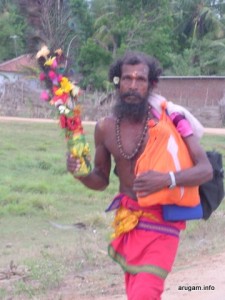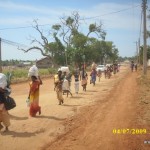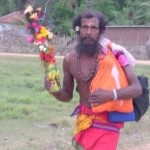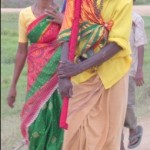
On the way to Okanda
Ventolin hfa 100 mcg price Opportunists and the irreverent, gaudily-clad masses have replaced the revered swamis and authentic pilgrims of yesteryear who made the journey to Sri Lankaa??s most famous shrine, says Patrick Harrigan
(July 24, Colombo, Sri Lanka Guardian) There is a Sinhala saying about Kataragama-bound pilgrims that goes:
DA?nagana giyot Kataragama, NodA?na giyot ataramaga.
Translated, it means: a??If you know the way, you come to Kataragama; if you dona??t know the way, you get completely lost.a??
- spotted nr. Arugam Bay bridge
- On the way to Okanda
- AbaY Outskirts. On the way to Okanda
- Kataragama Pilgrims leaving Arugam Bay
Those familiar with Kataragama know it as a place of sacred power, governed by an ever youthful spirit that defies human comprehension. Most pilgrims attest to a baffling a??unseen handa?? of a higher power prevailing at the age-old jungle shrine, even behind a crassly commercial facade. Astute politicians have also taken note.
Recognising the shrinea??s socio-political potential, some non-government organisations (NGOs) have jumped on the bandwagon by organising a mass march from Okanda to Kataragama, which they have styled a a??pada yatraa?? or traditional pilgrimage on foot. The ostensible purpose of the march is to honour the tradition of the Kataragama Pada Yatra.
In recent years the Pada Yatra has declined in popularity. Indeed, it has almost disappeared, along with the veteran swamis who preserved Kataragamaa??s traditions, songs, legends and ancient wisdom a?? all now slowly vanishing.
As recently as the 1990s, there were still a few poets, minstrels, musicians, dancers, clowns, and ecstatics in pilgrim garb among the barefoot faithful. Some would appear to walk alone across the awe-inspiring landscape of eastern Sri Lanka.
The old swamis have either passed away or they no longer walk. Fewer and fewer pilgrims sing as they walk, fewer still go barefoot and hardly any have any inherited wisdom to share. Once upon a time villagers competed with each other to fete these swamis and swami ammas with food and hospitality.
The swamis of yore have been replaced by families with children in tow who trudge in silence, clad in sandals and wearing outlandish clothes they would not consider wearing at home. Villagers along the route may offer them dana, but once only, and then urge them to continue on their way. Most do not walk if they can avoid it but ride the full distance by bus or tractor up to Okanda, and even into the national park.
More recent developments are the Pada Yatra youth societies and the NGOs with their tractors, luxury vehicles, tents, electric generators and all the signs of wealth that traditional pilgrims shun. Society members and employees march single-file dressed in uniform-like attire, each wearing fashionable footgear or headwear.
These youths are fielded as a??service volunteersa?? to serve the elderly but in reality they serve only themselves. During the day they rush ahead of the older pilgrims, leaving them to shoulder heavy burdens, and at night they listen, not to wisdom songs, but loud baila music sung to drums and radios.
What many pilgrims (including this writer) find most dismaying is the callous treatment given to tired foot pilgrims when they emerge from the jungle and face security checks.
The rag-tag poor and the elderly are ordered to wait in the scorching sun, while the uniformed members of well-heeled NGOs and other societies are courteously whisked through with minimal delay. In July 2007, I sat for hours with the poor pilgrims at the Varahana bridge.
The decline of the Pada Yatra did not occur overnight in a social vacuum, but in the context of a national decline affecting every village and town across the island, as reflected in the general scramble to grab land, possessions and power from neighbours and unborn generations.
Those great friends of Lankaa??s authentic traditions, such as Rene Guenon and Ananda Coomaraswamy, warned that the forces of anti-tradition would advance a counterfeit tradition as a substitute for the real thing, before replacing it with an anti-tradition diametrically opposed to spirituality.
In terms of culture and religion, the process is deadly, as we see in the decline of the Kandyan dance, which has deteriorated from a mystical tradition to shallow entertainment and a??dancing for dollarsa??.
The same process now threatens to subvert and destroy the islanda??s cultural and religious identity. Sri Lankans should re-assess their ancestral traditions if they wish to recover their authentic identities, and they should do so fast.
Generic zanaflex pictures The writer has walked the Kataragama Pada Yatra 20 times since 1972. A founding member of the Kataragama Devoteesa?? Trust, he has maintained the website www.kataragama.org since 1997.




 Arugam Forum
Arugam Forum Arugam Photo Galleries on Picasa
Arugam Photo Galleries on Picasa Old Website
Old Website Press Coverage
Press Coverage Surf Forecast for Arugam Bay
Surf Forecast for Arugam Bay
something to be done and experienced by the adventurous at heart 🙂
The Daily News says:
Pilgrims trek through Yala for Kataragama festival
Nelson PIYARATNE
A large group of Pada Yathra pilgrims, walking from as far as Trincomalee, have entered the Yala jungle and some have already reached Kataragama sacred city for July 22 flag hoisting ceremony at the Kataragama mosque marking the beginning of Kataragama Esala festival.
A large number of pilgrims are expected to reach Kataragama on foot through traditional jungle routes in the Yala National Park from eastern districts.
Pilgrims who walk from Trincomalee must commence journey forty days before the Kataragama Esala festival begins. Their numbers include not only Tamil Hindus, but also Tamil speaking Veddas, Sinhala Buddhists, Christians, Muslims and foreign pilgrims from Europe and America as well.
The pilgrims undertake simple vows of self-denial during the Kataragama season in return for God’s assistance in solving their personal problems.
Despite its hardships, traditional pilgrimage continue to grow in popularity in eastern districts, especially among the Tamils.
This year security forces anticipate that more than 10,000 foot pilgrims (Pada Yathra) will cross the Yala National Park before the festival end on August 6 with the peaceful atmosphere prevailing in the country with the annihilation of the LTTE.
The final 100 kilometres of the 400 kilometre walk from Trincomalee takes the pilgrims through uninhabited jungle of Yala Sanctuary. The pilgrims pay respects to local deities at such famous shrines as Koneswaram, Verugal, Sitthandi, Mamangam, Thanthamalai, Mandur, Tirukkovil and Okanda on their long trek to the Kataragama shrines.
For young and old pilgrims alike the Kataragama Pada Yatra is the opportunity of lifetime to visit all these renowned shrines in a single season. According to an American Pada Yathra pilgrim Patrick Harrigan, for centuries the Kataragama Pada Yathra tradition has been one of the great unifying factors in Sri Lankan society.